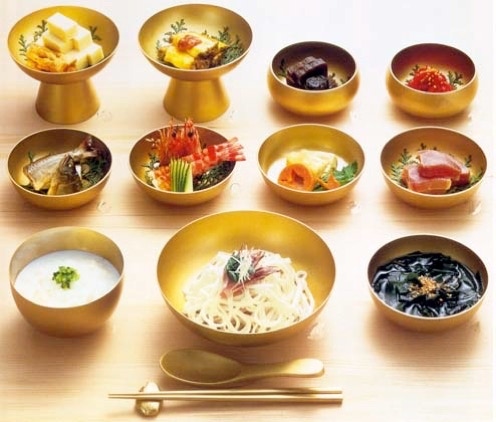food

One of the remarkable things about Murasaki's Tale of Genji, or her Diary—in fact the whole corpus of Japanese courtly literature—is that within those hundreds and hundreds of pages describing Heian life in which something like clothing is rhapsodized upon endlessly, mention of foods or scenes of eating are extremely rare. Indeed, there was something almost vulgar about the physical act of eating, and thus writers bent on depicting elegance did their best to avoid the subject altogether. Drinking parties appear frequently, inebriation is rife, but what did they snack on while sipping saké from unglazed ceramic cups?
Japanese food historians agree that Heian-era notions of cuisine were largely a continuation of earlier Nara-period culinary customs, and they are still recognizable as the basic tenets of Japanese cuisine today. There is great emphasis on plain ingredients prepared with a minimum of cookery. The cutting and slicing of food required much more skill than the actual cooking of it—if indeed it was "cooked" at all. The term for "chef" was hōchōnin, literally, "knife-wielder," and he sometimes prepared raw fish in front of banquet guests who could enjoy viewing his skill. Then, as now, the elegant presentation of bits of food composed on small plates was most important. Flavorings and sauces were piquant contrast to the food itself, usually served separately. These were not the sophisticated mixed-ingredient dishes of Chinese cuisine—think, rather, of dipping sushi in soy sauce. Fermented sauces like soy sauce (called hishio) and miso paste were introduced to Japan from China in the Nara period. Dumplings made of starch, deep fried, were also Chinese, and the Japanese of Murasaki's day referred to them as such—Kara okashi (Chinese sweets).
Rice was definitely a staple, (at least for the aristocracy) but it was usually served in the form of gruel. Often other grains or even legumes were mixed with it. My description of Murasaki's family's special gruel for the holiday of the first full moon of the year describes such a dish. Noodles were also eaten. They were called "barley strings" (muginawa)—that is a dough of barley flour rolled into long ropy shapes-the ancestor of soba noodles. The categories of cooking look very much like those one would see at a full course traditional banquet today.
There were:
Namamono. Raw flesh, also called sashimi. The meat of pheasant, carp, trout, sea bream, sea bass, octopus, abalone, and-a particular favorite, especially in summer-a small river fish called ayu.
Atsumono. Soups, such as clear broth with seaweed.
Nimono. Simmered foods. Usually vegetables such as carrots, onions, eggplants, radish, and garlic.
Yakimono. Grilled foods. Vegetables, meats, shrimp, or fish.
Agemono. Fried foods, such as deep-fried Chinese starch dumplings. Irimochi
were like today's senbei-crunchy crackers fried in sesame oil.
Mushimono. Steamed foods.
Yudemono. Boiled foods.
Tsukemono. Pickled foods. Vegetables or meats preserved by salting or pickling in vinegar.
And then there were the odd things like milk, a partially dried and fermented diary product called so (that I have translated as "cheese") and in the summer, sno-cones.
Recipe for a Heian sno-cone:
Have your servant fetch a block of ice from the "ice room" administered by the Imperial Household Agency, bring it quickly to your quarters, and shave chips off it into a silver bowl. Pour amazura (liana vine) syrup over the mound and eat before it melts with a shell spoon.
Meals were usually taken twice a day, at mid-morning (around 10:00) and mid-afternoon (around 4:00), but the practice of snacking appears to have been common.